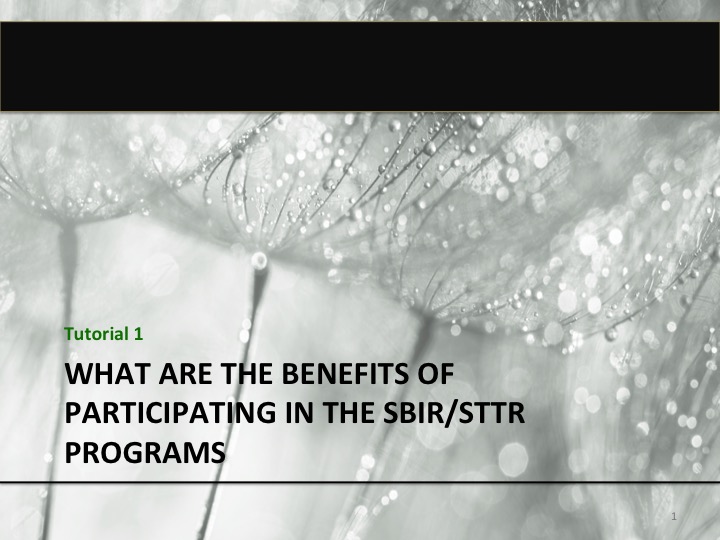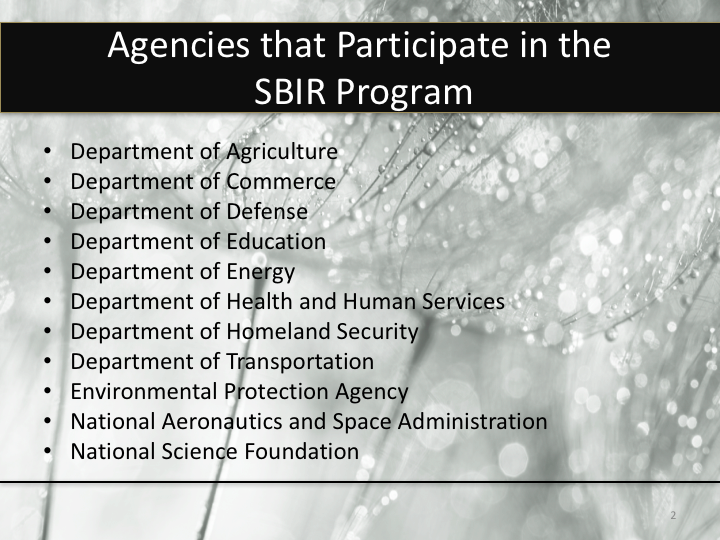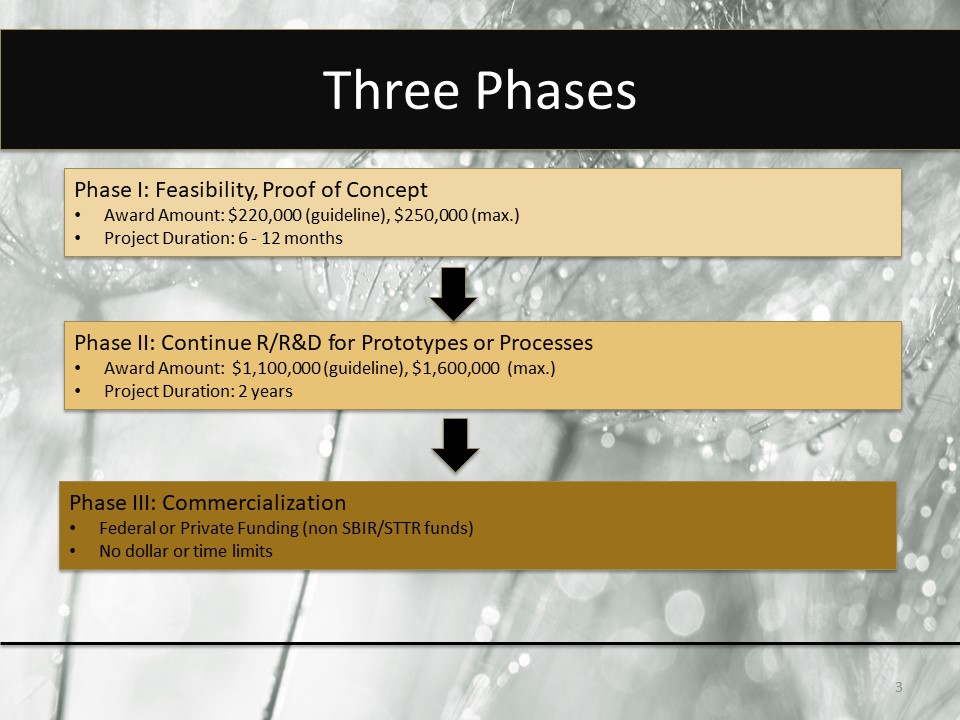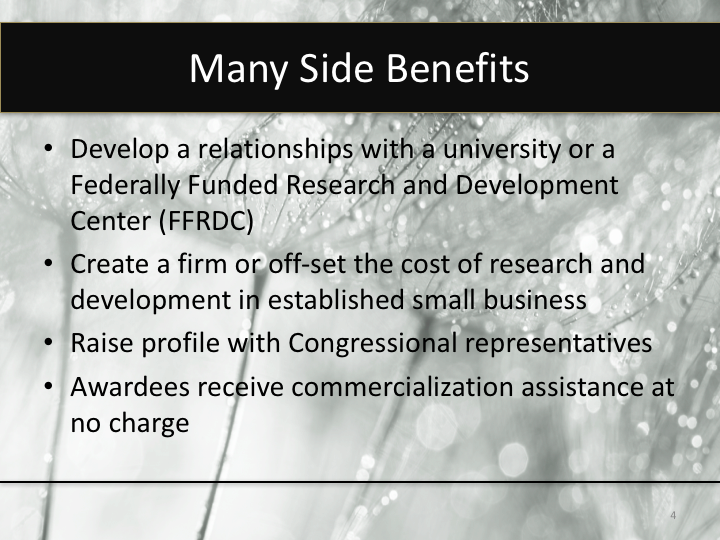Tutorial 1:
What are the benefits of participating in the SBIR/STTR programs?
This is the first in a series of tutorials designed to assist you in preparing a proposal in response to a Department of Energy Funding Opportunity Announcement or FOA. In this tutorial we will introduce you to the basic benefits of participating in either the Small Business Innovation Research program, also referred to as SBIR or the Small Business Technology Transfer program referred to as STTR.
These two initiatives, the SBIR and STTR programs are sometimes referred to as the nation’s largest source of early stage/high risk funding for start ups and small business. To be eligible the small business must be American-owned, organized as a for profit entity and have less than 500 employees. There are 11 federal agencies that participate annually in the SBIR program and five that participate in the STTR program.
These agencies designate R&D topics and accept proposals. They fund innovative research that will meet the objectives of each Agency. Each has a unique mission and should be viewed as distinct customers. After this initial introduction we will focus on one agency – the Department of Energy and will assist you in learning how to prepare a responsive Phase I SBIR or STTR proposal.
The original charter of the SBIR and STTR programs was to address four goals.
- First to stimulate technological innovation
- Second to use small business to meet Federal R/R&D needs
- Third, to foster and encourage participation in technological innovation by socially and economically disadvantaged small businesses, as well as those that are 51 percent owned and controlled by women, and
- Fourth to increase private sector commercialization of innovations derived from Federal research and development thereby increasing competition, productivity, and economic growth
Since the program began in 1982, the charter has expanded to:
- Require evaluation of commercial potential in Phase I and Phase II applications
- Make awards that are comparable in size to angel investments in the private sector
- Encourage the federal agencies to accept greater risk in support of agency missions
Both the SBIR and STTR programs have three Phases: Following submission of proposals, agencies make SBIR awards based on small business qualification, degree of innovation, technical merit, and future market potential. Small businesses that receive awards then begin a three-phase program.
- Phase I is the concept phase. It lasts six to twelve months and supports exploration of the technical merit or feasibility of an idea or technology.
- Phase II awards may last for up to 2 years and expand upon the Phase I results. During this time, the R&D work is performed. Only Phase I award winners are considered for Phase II.
- Phase III is the period during which a Phase II innovation moves from the laboratory into the marketplace. No SBIR funds support this phase. The small business must find funding in the private sector or other non-SBIR federal agency funding to support continued development.
In the Department of Energy’s Program, Phase I awards are up to $150,000 or $225,000 depending on the topic. Phase I research is conducted over a 9 – 12 month period. Phase II is the principal R&D effort with awards up to $1.5 million dollars over a two-year period. Phase III offers opportunities to small businesses to continue their Phase I and II R&D work to pursue commercial applications of their research and development with non-SBIR or STTR funding. Under Phase III, Federal agencies may award non-competitive, follow-on grants or contracts for products or processes that meet the mission needs of those agencies, or for further R&D.
To succeed in these programs there are a number of prerequisites:
- First, you must have a burning desire to conduct research and development
- AND a desire to develop a viable product that you want to bring to the marketplace ——Just wanting to do research is insufficient – you must want to see that research commercialized or turned into a useful product that you and your firm will promote either directly or through a variety of commercialization strategies.
If you can match your interests and talents with the specific needs of a federal agency you may be able to secure funding to conduct research and development with no strings attached. By applying for and winning an SBIR or STTR award, you will receive funding to conduct the R&D, retain the rights to the intellectual property and have the opportunity to obtain additional funding to continue the development of the technology. The SBIR and STTR programs provide a unique opportunity for scientists and engineers to develop and grow a small business.
But don’t get ahead of yourself – Often, when people first hear about the SBIR program they ask the following question – if I have already developed a solution can I apply? No – the SBIR and STTR programs fund research and development – the purpose is not to retroactively pay a company for development that they may have already accomplished. However, it is assumed that you have an area of expertise and perhaps related work.
The Department of Energy’s SBIR/STTR program office provides the opportunity to increase “private sector commercialization of technology developed through DOE-supported research and development, stimulating technological innovation in the private sector, and improving the return on investment from Federally-funded research for economic and social benefits to the nation.” Small businesses benefit from receiving funding with no strings attached – you do not give up equity in your company, you do not give up rights to the intellectual property, you do not return the funding – as this is not a loan. What is expected is good research that will lead to a commercial product that will benefit the nation.
Now, there are many side benefits depending on how you formulate your research. You can use your proposal as an opportunity to develop a relationship with a university or with a Federally Funded Research and Development Center, referred to as an FFRDC. You can use this as an opportunity to create a firm or as a means of off-setting the cost of research and development in an established small business. Once you win an award the DOE will notify your Congressional representatives – thus raising the profile of your firm at the state level. The DOE will also make a variety of commercialization services available to you at no charge to assist in the successful commercialization of your technology. The benefits of becoming involved with the DOE SBIR/STTR program abound!
Quiz: Tutorial 1: What are the benefits of participating in the SBIR/STTR programs?
1
Which of the following is NOT a benefit of participating in the SBIR program?
Nice Work
Try Again
2
How many Funding Opportunity Announcements (FOA) does the DOE SBIR/STTR program office typically have each year?
Nice Work
Try Again
3
Which of the following is a true statement regarding when applicants can submit a proposal to the DOE SBIR/STTR program office?
Nice Work
Try Again
4
What is the most common size of a Phase I SBIR award from DOE?
Nice Work
Try Again
5
What is the major difference between the SBIR and STTR programs?
Nice Work
Try Again
6
The following is NOT found in the list of DOE Topics when released
Nice Work
Try Again



